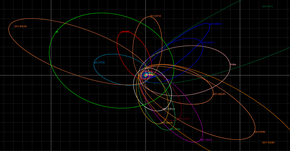User:Kepler-1229b/2015 DM319
 The orbits of 2015 DM319 (top left; red) and other detached objects, along with the hypothetical Planet Nine's orbit (left; green) | |
| Discovery | |
|---|---|
| Discovered by | OSSOS |
| Discovery site | Mauna Kea Obs. |
| Discovery date | 25 February 2015 |
| Designations | |
| uo5m93[1] | |
| Detached object · TNO · distant[2] | |
| Orbital characteristics | |
| Epoch 13 September 2023 (JD 2460200.5) | |
| Uncertainty parameter 7[2] · 3[3] | |
| Observation arc | 2158 days (5.908 yr) |
| Earliest precovery date | 1 August 2011 |
| Aphelion | 505.113 AU |
| Perihelion | 39.4913276 AU |
| 272.3023005 AU | |
| Eccentricity | 0.8549725 |
| 4,493 years | |
| 1.83454° | |
| 0.00021930°/day | |
| Inclination | 6.83942° |
| 166.03444° | |
| 43.22674° | |
| Physical characteristics[4] | |
| 25.4 | |
| 8.78 | |
2015 DM319, previously known as uo5m93, is an extreme trans-Neptunian object orbiting in the Kuiper belt of the outermost Solar System. It was first observed by the Outer Solar System Origins Survey using the Canada–France–Hawaii Telescope at Mauna Kea on 25 February 2015.[2]
Description[edit]
It is one a small number of detached objects with perihelion distances of 30 AU or more, and semi-major axes of 250 AU or more.[5] Such objects cannot reach such orbits without some perturbing object, which has led to the Planet Nine hypothesis, that a massive trans-Neptunian planet is the perturber.
References[edit]
- ^ Shankman, Cory; et al. (2017). "OSSOS. VI. Striking Biases in the Detection of Large Semimajor Axis Trans-Neptunian Objects". The Astronomical Journal. 154 (2): 50. arXiv:1706.05348. Bibcode:2017AJ....154...50S. doi:10.3847/1538-3881/aa7aed. hdl:10150/625487. S2CID 3535702.
- ^ a b c "2015 DM319". Minor Planet Center. Retrieved 5 December 2023.
- ^ "Small-Body Database Lookup". ssd.jpl.nasa.gov. Retrieved 6 December 2023.
- ^ "MPEC 2023-X37 : 2015 DM319". Minor Planet Center. Retrieved 5 December 2023.
- ^ "IAU Minor Planet Center".
# # Category:Minor planet object articles (unnumbered) Category:Discoveries by OSSOS 20150225
